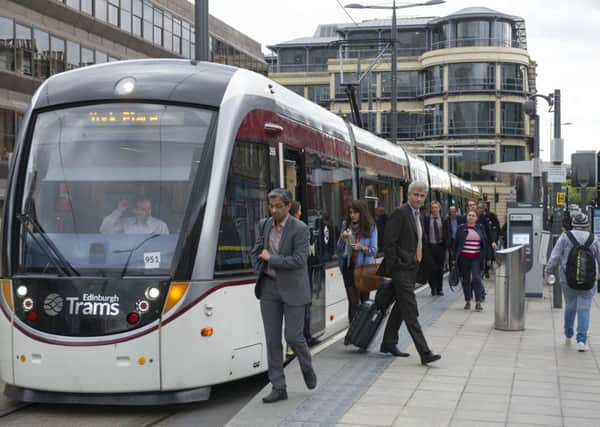John McLellan: A public transport scheme that doesn't cost £165m


Nothing suggests the SNP/Labour administration is not determined to press ahead, and it was telling that the Conservative group, the only party still opposing the scheme, was kept in the dark about a significant announcement about the tendering process.
The naming of the four companies competing for the contract last month was a significant moment, but in an official briefing about the project’s progress for Tory councillors the night before strangely there was no mention of it. As the kids say, whatevs, but we still await an explanation.
Advertisement
Hide AdAdvertisement
Hide AdBut it’s also fair to say that the determination to proceed in principle doesn’t mean there will be no changes to the details, and going by recent experience then the proposed Leith Walk road lay-out will be adjusted following the public consultation.
As reported here, even though contracts were signed for changes to the Picardy Place junction, that didn’t stop the administration jamming on the anchors when pressured by the cycling lobby and ordering a reconfiguration which will cost the tax-payer an extra £6m.
So with loud complaints from the same sources about the Leith Walk proposal, a re-think is not only possible but probably inevitable, no matter the financial implications.
Which brings me to a conundrum. A proposal exists which could improve public transport, create a faster link to a major transport hub, will not disrupt existing traffic flow and, what’s more, it’s at minimal cost to the tax-payer. Yet those behind the scheme say there has been scant interest from the council. How can this be?
Advertisement
Hide AdAdvertisement
Hide AdIt involves the new access road Edinburgh Airport wants to create through the site made available by the closure of the original Turnhouse runway which finally went out of action last week. The so-called Crosswind project aims to develop the wedge of airport land running to the Gogar Junction with the new road running from Myreton Drive to the heart of the terminal.
Mindful of the political difficulties of anything encouraging car use, the airport is now prepared to dedicate the route to public transport, which would take buses from the city centre off the A8 and the chaotic Eastfield Road. Lothian Buses has reacted positively, but airport sources believe a fear that successful commercial expansion would damage the International Business Gateway project on the north side of the Glasgow Road is behind the council’s reluctance to engage in constructive discussions.
On the sandwich shop principle of opening one next to another, a commercial success on one site next to the airport should encourage others, but at the moment all that exists of the IBG are artists’ impressions.
Such is the exasperation, the airport is now considering using its planning exemptions to get cracking with the preparatory work to bring the new road right up to the boundary and, in the meantime, explore what can be done with the minor road access to the Cargo Village off Turnhouse Road.
Advertisement
Hide AdAdvertisement
Hide AdNone of the council’s laudable ambitions to tackle the housing crisis and beat social exclusion can be achieved without economic growth and the airport is central to Edinburgh’s global competitiveness on which so much wealth creation will depend.
It would be a lot easier to work with the airport rather than find reasons to hold it back, and with the Scottish economy growing at half the pace of the rest of the UK, the city needs all the help it can get.
– It’s hard to argue with the Old Town Community Council’s observations about the state of the streets; the Lawnmarket in particular is more like a river bed than a road. Their dossier was produced in November and raised at the council by my colleague Jo Mowat in December, but a final official response is still some way off.
World Heritage plan falls short
By common consent the new World Heritage Site management plan for the next five years should be a positive move for both those concerned about threats to Edinburgh’s historic core and those wishing to take advantage of all it has to offer. Clearly laying out the dos and don’ts of development in such a sensitive site should actually make it easier for developers who will know what to avoid if their plans are to pass muster. Or so the theory goes.
Advertisement
Hide AdAdvertisement
Hide AdThat depends on the clarity of the guidance, yet the 100-page document is dominated by woolly recommendations which have such latitude for interpretation as to be almost worthless as a means of avoiding disputes like India Buildings or Soco.
A beautifully illustrated and well-written brief history of the Old and New Towns it undoubtedly is, but it falls short of being the bible for city centre planners.
Near tragedy shows council can’t skimp on planning and building control
As well as emphasising the need for investment in the maintenance of Edinburgh’s public buildings, the Audit Scotland report into the Oxgangs Primary wall collapse highlights the importance of boosting the city’s building control and inspection departments.
Advertisement
Hide AdAdvertisement
Hide AdThe city can’t function without properly resourced planning and building departments – applications don’t get processed quickly enough and problems arise the more the departments are under pressure. Skimping on this is a false economy and it was nearly a tragic one.
